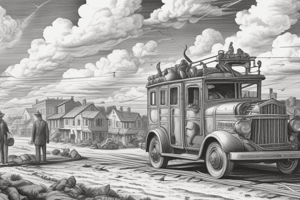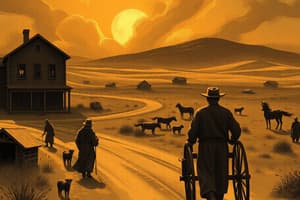Podcast
Questions and Answers
Which of the following policies was a major component of the New Deal?
Which of the following policies was a major component of the New Deal?
- The creation of the Federal Deposit Insurance Corporation (FDIC) to protect bank deposits
- The implementation of a national system of unemployment insurance
- The establishment of the Social Security Administration (SSA) to provide retirement benefits
- All of the above (correct)
What was the main purpose of the Neutrality Acts passed in the 1930s by the United States?
What was the main purpose of the Neutrality Acts passed in the 1930s by the United States?
- To establish a system of alliances with other countries to deter aggression
- To immediately declare war on any country that attacked another nation
- To provide military aid and support to any country fighting against fascism
- To maintain a policy of isolationism and avoid involvement in foreign wars (correct)
Which of the following BEST describes the impact of Executive Order 9066 during World War II?
Which of the following BEST describes the impact of Executive Order 9066 during World War II?
- It established the GI Bill of Rights for returning veterans
- It authorized the use of the atomic bomb against Japan
- It banned discrimination against African Americans in the military and defense industries
- It ordered the internment of Japanese Americans in camps during the war (correct)
How did the Dust Bowl significantly contribute to the Great Depression?
How did the Dust Bowl significantly contribute to the Great Depression?
What was the "Double V" campaign, and who was it primarily associated with?
What was the "Double V" campaign, and who was it primarily associated with?
Flashcards
Great Depression
Great Depression
A severe global economic downturn in the 1930s.
Black Tuesday
Black Tuesday
The day (October 29, 1929) when the stock market crashed.
Dust Bowl
Dust Bowl
A period of severe dust storms in the 1930s causing agricultural damage.
The New Deal
The New Deal
Signup and view all the flashcards
Executive Order 9066
Executive Order 9066
Signup and view all the flashcards
Study Notes
The Great Depression
- The Great Depression was a severe worldwide economic downturn that lasted from the late 1920s to the late 1930s.
- Causes included credit/installment plans, stock market speculation, and unequal distribution of wealth.
- Black Tuesday refers to the stock market crash of October 29, 1929.
- Bank runs occurred as people panicked and withdrew their money from banks, leading to bank failures.
- Herbert Hoover's policies during the Depression, known as Hoover's approach, focused on rugged individualism and limited government intervention.
- The Dust Bowl was a severe drought and dust storms affecting the American prairies during the 1930s. Causes included drought, over-farming, and severe wind conditions.
- Hoovervilles were shantytowns built by homeless people during the Great Depression.
- The Bonus Army was a group of World War I veterans who protested for early payment of their promised bonuses.
The New Deal
- Franklin D. Roosevelt's New Deal aimed to address the economic and social problems caused by the Depression.
- Fireside Chats were radio addresses given by President Roosevelt to the American people to gain their confidence and approval.
- Eleanor Roosevelt played a significant role in advocating for social reform during the New Deal.
- The New Deal included various programs, such as the establishment of regulating bodies.
- The Social Security Act (SSA) established a system of social security benefits and aid.
- The Securities and Exchange Commission (SEC) aimed to regulate the stock market.
- The Federal Deposit Insurance Corporation (FDIC) ensured bank deposits.
- The Indian Reorganization Act of 1934 aimed to preserve Native American cultures and tribal governments.
- The New Deal's legacies included a larger role for the federal government in the economy and society. The New Deal created a foundation for the modern welfare state.
World War II
- American involvement in World War II was driven by conflicts between isolationists and interventionists.
- The Neutrality Acts of 1935 and 1937 aimed to keep the United States out of the war. The Neutrality Act of 1939, referred to as Cash and Carry, allowed certain countries to purchase military goods.
- The Lend-Lease Act provided aid to Allied nations fighting Nazi Germany.
- Pearl Harbor was the surprise attack by Japan that led to the United States' entry into World War II.
- Executive Order 9066 led to the internment of Japanese Americans during World War II. Executive Order 8802 prohibited discrimination in employment based on race.
- The Tuskegee Airmen were a highly skilled African American squadron of fighter pilots. The Double V Campaign highlighted the need for both victory in World War II and victory on the home front for racial equality.
- D-Day marked the Allied invasion of Normandy, France. This operation marked the beginning of the end of German control.
- The Island Hopping campaign emphasized strategy in the Pacific Theater.
- The Manhattan Project developed the atomic bomb.
- Post-war legacies included the United States' emergence as a global superpower.
- Executive Order 9981 desegregated the US Armed Forces.
- The GI Bill provided benefits for returning veterans, offering education and financial assistance.
Economic Policies during the Great Depression and New Deal
- Rugged Individualism: Herbert Hoover's belief that people should be self-reliant.
- Liberal vs. Conservative Economic Policy: Differences in views regarding the role of government in the economy during the Great Depression. Liberals advocated for a more active government role, while conservatives favored limited intervention.
- Deficit Spending: Increased government spending above tax revenue during the New Deal.
Studying That Suits You
Use AI to generate personalized quizzes and flashcards to suit your learning preferences.




